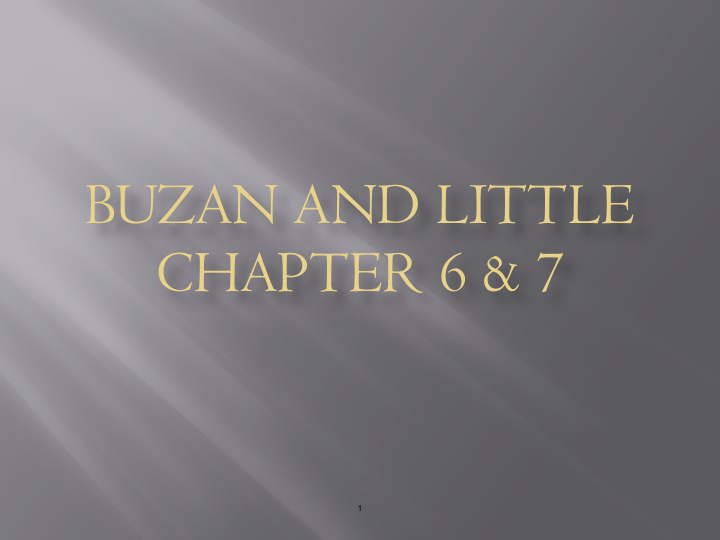



BUZAN AND LITTLE CHAPTER 6 & 7 1
Pre-International Systems • Pre-International systems continue to exist today � San (Bushmen) in Southern Africa � Spinifex people, or Pila Nguru of Australia � Uncontacted tribes in Amazon. � Sentinelese: Andamanese indigenous peoples of the Andaman Island � Pre-International systems represent the most (geographically) successful human systems. � Far more successful than states at adapting to and dealing with all the varieties on earth. 2
Pre-International Systems Discuss : • What are the units of the pre-international systems? • How does interaction capacity emerge in the Pre- International System • What are Pre-International System processes? • Is there a Pre-International Systemic structure? • Does the Buzan and Little toolkit apply well to Pre- International System? Do any other existing theories? 3
Pre-international units • Internal structure: authority rather than power • Mobile, egalitarian HGB • NOT isolated! • Weak territoriality 4
Pre-international interaction capacity • Directly related to population density (why?) • Survival requires cooperation (a process), but cooperation requires interaction capacity. How to do this? � Physical technology = fixed � Geography = fixed � Social technology = winner! 5
Pre-international interaction capacity • Language • Maximize number of neighbors 6
Pre-international Processes • Three main processes � Marriage � Gatherings � Exchange of goods � Maybe a little fighting on the side 7
Pre-international Structure • Largely unstructured in the mechanical sense � Low interaction capacity means no sectors other than social and limited economic, not enough depth to really support structure • There are some social structures though � Totems � Primordial world society 8
Peer Instruction • What marks the transition from Pre- International systems to international systems? 9
This image is in the public domain. Source: Wikimedia Commons. Image courtesy of Sean Dreilinger on flickr. License CC BY-NC-SA. Transition: pre-international to international system • Began and ended at different times in different places � That said, for most part began 20,000-10,000 BC • Two fundamental transition � 1: ➔ � 2. Hierarchy 10
Transition Units • Egalitarian villages (small) • Hierarchical chiefdoms 11
Transition Interaction capacity • Large increase in languages (what does this mean for interaction capacity?) • Decreasing distances as population density increases • Rise of elite languages • Weakening of interunit social networks 12
Transition Process • Egalitarian tribes � Political/military: raiding, conflict becomes a constant of life � Economic: Food storage and trade, prestige goods � Societal: maintaining trade links • Chiefdoms � Political/military: warfare becomes significant, mixed bag for leaders � Economic: consolidation of hierarchy most effectively accounted for by economic processes, agriculture � Societal: Hierarchy attached to individuals, external relations elevated top chief 13
Transition Process • Social and economic structures deeply intertwined • Some movement toward structure in the Neorealist, military-political sense • Rough state of anarchy, but the system is not structured. Indeed, raises questions about Neorealist story… 14
MIT OpenCourseWare https://ocw.mit.edu/ 17.41 Introduction to International Relations Spring 2018 For information about citing these materials or our Terms of Use, visit: https://ocw.mit.edu/terms.
Recommend
More recommend